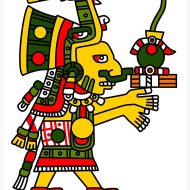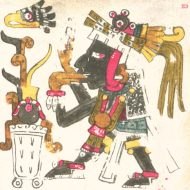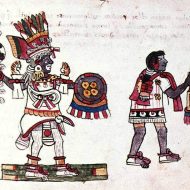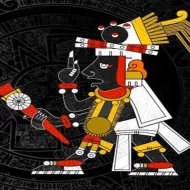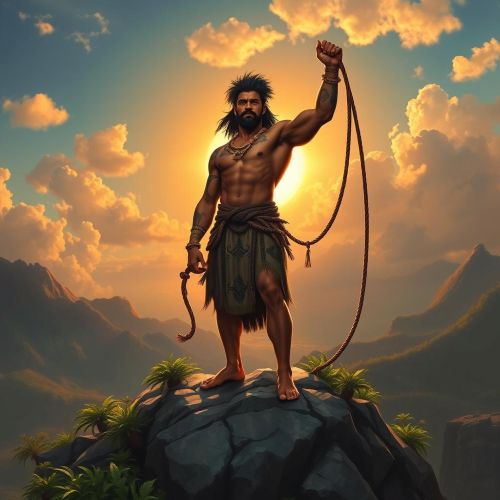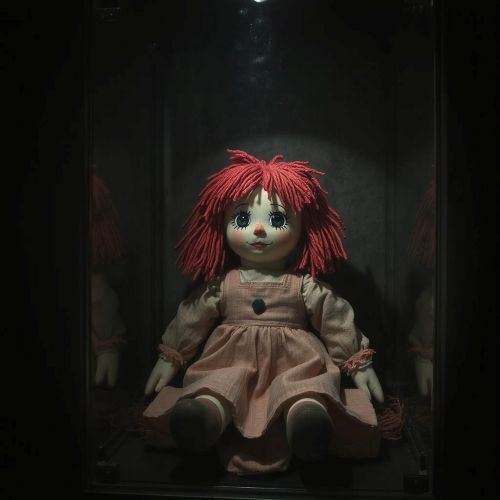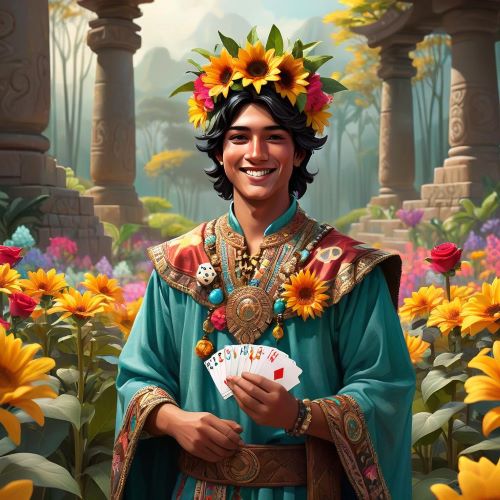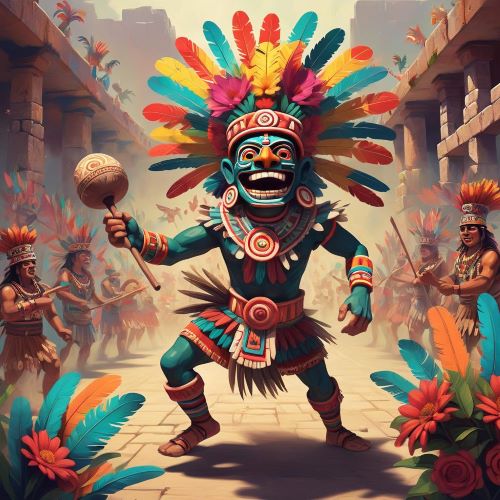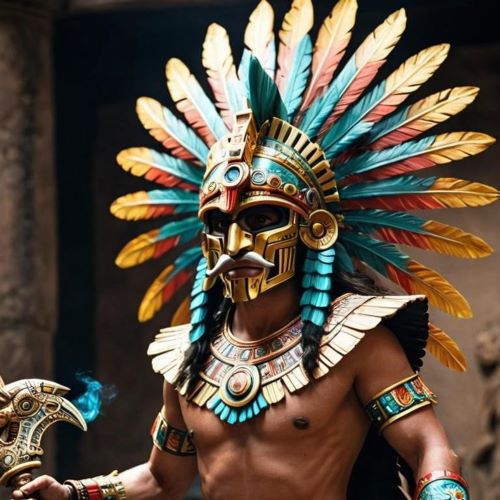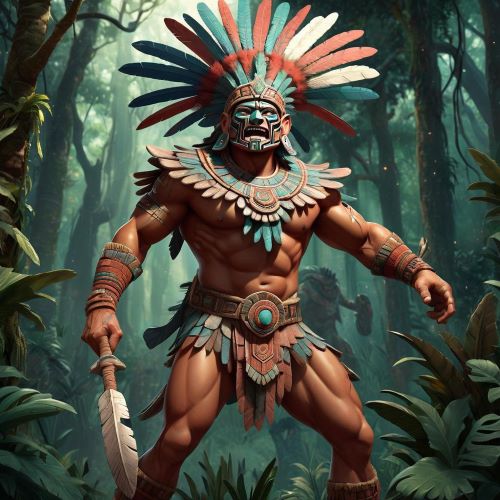Ixtlilton : God of Medicine
Listen
At a glance
| Description | |
|---|---|
| Origin | Aztec Mythology |
| Classification | Gods |
| Family Members | Macuilxochitl (Brother) |
| Region | Mexico |
| Associated With | Healing, Medicine |
Ixtlilton
Introduction
Ixtlilton, alternatively known as ‘Small Black Face,’ holds a prominent place in Aztec mythology, revered as the deity of medicine and healing. The name “Ixtlilton” finds its roots in Nahuatl languages, translating to ‘ink at the face.’ This benevolent god is frequently linked to Macuilxochitl‘s brother, the god associated with well-being and good luck. Despite being overshadowed by more widely recognized Aztec gods like Quetzalcoatl and Huitzilopochtli, Ixtlilton plays a pivotal role in the cultural and mythological narrative of the ancient Aztecs.
Physical Traits
Representations of Ixtlilton exhibit variations, yet a consistent theme unifies them. Frequently depicted as a dark-skinned youth, his features of obsidian softened by a playful grin, Ixtlilton wears a black mask adorned with feathers, symbolizing the healing darkness he embodies. Bedecked in vibrant ornaments of jade and turquoise, his portrayal echoes the life-infusing energy flowing through him. Some renditions depict him adorned with emblems of the sun, subtly alluding to his connection to renewal and the promise of new dawns.
In his agile hands, Ixtlilton may clutch a staff, a mirror for divination, or even a rattle, his dance steps shaking away maladies and ushering in joy. The symbolism extends beyond his physical appearance, reflecting the multifaceted nature of his role in defying illnesses and spreading a sense of well-being.
Additionally, Ixtlilton is often associated with an obsidian mask, believed to bring a soothing darkness and peaceful sleep to children at night. His depictions incorporate sun-related symbols, such as the fan of red arara feathers, sun flags, and emblems embellishing his clothing and sandals. These elements collectively paint a vivid picture of Ixtlilton’s complex persona, intertwining healing, protection, and the vibrant essence of celebratory joy.
Family
In the tapestry of Aztec mythology, Ixtlilton is frequently referenced as the sibling of Macuilxochitl, the god presiding over well-being and good fortune. Furthermore, he shares an association with Xochipilli, forming a trio that symbolizes health, pleasure, and happiness within the Aztec mythological framework. Though the specifics of Ixtlilton’s lineage weave through various narratives, a consistent theme emerges — he is notably the brother of Macuilxochitl, the playful deity overseeing games and good fortune.
This familial connection underscores the profound link between health and happiness, serving as a poignant reminder that laughter and joy are potent remedies in themselves. Some sources also attribute Ixtlilton as the offspring of the creator couple Tonacatecuhtli and Tonacacíhuatl, positioning him at the very core of Aztec cosmology. This lineage highlights his integral role in the cosmic order and his influence over aspects of creation.
Furthermore, Ixtlilton’s connections extend to other deities, including Xochipilli and Xochiquetzal, the gods respectively associated with flowers and beauty. These associations reinforce his ties to the vitality of life and the delicate dance between darkness and light. In contemplating the intricate interplay of these divine relationships, Ixtlilton emerges as a deity intricately woven into the fabric of Aztec mythology, embodying the interconnectedness of health, happiness, and the eternal cycle of existence.
Other names
In addition to being referred to as ‘Small Black Face,’ Ixtlilton goes by the name Tlaltetecuin, signifying ‘the lord of the black water tlilatl.’ Like many deities of antiquity, Ixtlilton dons various masks, each unveiling a distinct facet of his intricate essence. On occasions, he is recognized as Tlaltetecuin, “Lord of the Black Water,” a title that alludes to the healing properties associated with dark, volcanic springs. Alternatively, some invoke him as Ixtliltzin, “Little Ixtlil,” imbuing his name with a tender reverence.
Yet another epithet, Piltzintecuhtli, translates to “Lord of the Young Doctors,” shedding light on his role as the patron of healers and their apprentices. These diverse names and titles contribute to the multifaceted nature of Ixtlilton, showcasing the layers of his character and the various roles he assumes in the intricate tapestry of Aztec mythology.
Powers and Abilities
Ixtlilton played a pivotal role in Aztec society, especially in matters concerning health and well-being. As the god of medicine, he wielded the remarkable ability to heal diseases and remedy ailments with a mere touch. His healing prowess, however, transcended the physical realm, encompassing the spiritual and emotional dimensions of well-being. Engaging in hydromancy, a form of divination utilizing reflections in dark water, Ixtlilton demonstrated a unique and nuanced approach to understanding and addressing health concerns.
In stark contrast to warrior gods brandishing thunderbolts or fiery arrows, Ixtlilton’s strength resided in a gentle touch and a soothing presence that alleviated anxieties and dispelled sickness. Revered as the protector of children, he would visit their bedside at night, enveloping them in the healing embrace of darkness. Belief held that his obsidian mask possessed the power to ward off nightmares, ushering in peaceful sleep and providing a sanctuary for the body and spirit to recuperate under the cover of night.
Ixtlilton’s proficiency in divination enabled him to diagnose ailments and identify curative herbs, guiding healers on their quest to restore health. Additionally, his association with dance, laughter, and play underscored the therapeutic potency of joy in dispelling the shadows of illness. In essence, Ixtlilton’s multifaceted role as a healer and guardian encapsulated a holistic understanding of well-being, intertwining physical, spiritual, and emotional dimensions in the pursuit of health within the vibrant tapestry of Aztec culture.
Modern Day Influence
Ixtlilton’s influence extends across diverse facets of society, leaving an indelible mark on art, dance, and divination. His significance in the realm of medicine is deeply ingrained, with a belief that he possesses the knowledge and expertise to restore health and well-being. Importantly, his association with medicine transcends mere physical healing, underscoring the holistic nature of his curative abilities.
Despite the passage of centuries since the Aztec empire, Ixtlilton’s legacy continues to reverberate in contemporary times. The reverence for medicinal plants and the acknowledgment of the intricate link between mental well-being and physical health resonate in modern holistic practices. The recognition of the therapeutic value of laughter and play, championed by child development specialists and complementary therapists, reflects the sagacity encapsulated by the dancing god.
Furthermore, the imagery of a dark-skinned protector finds echoes in present-day narratives of triumphing over illness and adversity with resilience and joy. In this way, Ixtlilton’s enduring influence endures as a timeless source of inspiration, contributing to the ongoing dialogue on holistic well-being and the interconnectedness of physical, mental, and emotional health in contemporary society.
Related Images
Frequently Asked Questions
What is lorem Ipsum?
I am text block. Click edit button to change this text. Lorem ipsum dolor sit amet, consectetur adipiscing elit. Ut elit tellus, luctus nec ullamcorper mattis, pulvinar dapibus leo.
What is lorem Ipsum?
I am text block. Click edit button to change this text. Lorem ipsum dolor sit amet, consectetur adipiscing elit. Ut elit tellus, luctus nec ullamcorper mattis, pulvinar dapibus leo.
What is lorem Ipsum?
I am text block. Click edit button to change this text. Lorem ipsum dolor sit amet, consectetur adipiscing elit. Ut elit tellus, luctus nec ullamcorper mattis, pulvinar dapibus leo.
What is lorem Ipsum?
I am text block. Click edit button to change this text. Lorem ipsum dolor sit amet, consectetur adipiscing elit. Ut elit tellus, luctus nec ullamcorper mattis, pulvinar dapibus leo.
What is lorem Ipsum?
I am text block. Click edit button to change this text. Lorem ipsum dolor sit amet, consectetur adipiscing elit. Ut elit tellus, luctus nec ullamcorper mattis, pulvinar dapibus leo.

